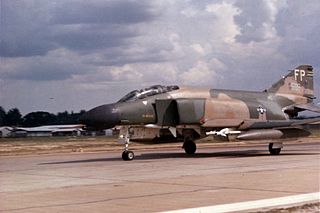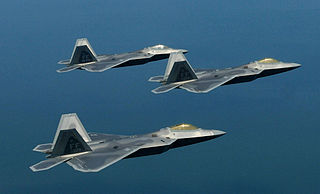The finger-four formation (also known as the "four finger formation" and the "Fingertip Formation") is a flight formation used by fighter aircraft. It consists of four aircraft, and four of these formations can be combined into a squadron formation.
The finger-four formation (also known as the "four finger formation" and the "Fingertip Formation") is a flight formation used by fighter aircraft. It consists of four aircraft, and four of these formations can be combined into a squadron formation.
The formation consists of a flight of four aircraft, consisting of a "lead element" and a "second element", each of two aircraft. When viewing the formation from above, the positions of the planes resemble the tips of the four fingers of a human right hand (without the thumb), giving the formation its name.


The lead element is made up of the flight leader at the very front of the formation and one wingman to his rear left. The second element is made up of an additional two planes, the element leader and his wingman. The element leader is to the right and rear of the flight leader, followed by the element wingman to his right and rear.
Both the flight leader and element leader have offensive roles, in that they are the ones to open fire on enemy aircraft while the flight remains intact. Their wingmen have a defensive role—the flight wingman covers the rear of the second element and the element wingman covers the rear of the lead element.
Four of these flights can be assembled to form a squadron formation which consists of two staggered lines of fighters, one in front of the other. Each flight is usually designated by a color (i.e. Red, Blue, Yellow, and Green).
One disadvantage of the finger-four formation was that it left the least-experienced flier, the number two wingman, in the most exposed position (as "tail-end Charlie"). These were particularly vulnerable to a surprise diving attack, and in some cases could be picked off without the others in the formation even noticing.
The formation was developed by several air forces independently in the 1930s. The Finnish Air Force adopted it in 1934 and 1935. [1] [2] Luftwaffe pilots developed the formation independently in 1938 during the Spanish Civil War, and were the first to use it in combat.[ citation needed ]
During the 1930s, the Finnish Air Force, aware of its weakness in numbers compared to its neighbours, sought to offset the disadvantage by a radical rethink of its tactics. The new tactical philosophy emphasized aggression, a willingness to attack regardless of the odds, as well as shooting accuracy at a time when aerobatic skill was prized by most air forces. Hand in hand with the changes was the adoption of the pair and finger-four formation, which allowed economy and gave the flexibility that the new tactics required. The aircraft in the new formations had greater vertical and horizontal separation and so they were free to scan in all directions for enemy aircraft, rather than focusing on maintaining a close formation. That allowed the pilots to maintain greater situational awareness and reduced their chance of being spotted by the enemy. The two pairs could split and attack on their own. The pilot who spotted the enemy would become the leader of the pair or even the whole flight for the duration of the attack, as he had the best situational awareness at that moment.
With no guarantee of success, the FAF adopted the new tactics and was later to find the validity of this approach during the Winter War (1939–1940) with the Soviet Union. The Finnish Air Force proved their effectiveness by achieving a 16:1 kill ratio with the finger-four against the Soviet Air Force, which used the conventional Vic formation. [2]
Involvement in the Spanish Civil War gave the fledgling Luftwaffe an early experience of combat conditions, but the "Condor Legion" quickly found its main fighter aircraft, the He 51, was outclassed by the Soviet I-16 in service with the Republicans. The new Bf 109B was effective but in short supply. For some time, only six were available, making the 3-plane Kette impractical. Flying in pairs (Rotte) or a two-pair Schwarm and using a more open formation (made possible by radio communication between aircraft) was found to confer other benefits.
Most notable in its development and use in the Luftwaffe were Günther Lützow and Werner Mölders and their fellow airmen. In the Luftwaffe, the flight (German : Schwarm) was made up of two pairs (German : Rotte) of aircraft. Each Rotte was composed of a leader and a wingman. The Rottenführer (pair leader) would attack enemy aircraft, leave his wingman to scan for threats and protect him while he engaged the enemy. The Germans thus eschewed the Finnish Air Force's more flexible approach.
The Luftwaffe continued the use of the formation during its Battle of France, the Battle of Britain and the invasion of the Soviet Union in which its effectiveness was shown to be considerably greater than the standard three-aircraft "Vic" close formation used by its opponents. [3] Later, the RAF, the United States Army Air Forces (USAAF) and Soviet Air Forces adapted their tactics.
The Soviet Air Force units in the Spanish Civil War soon adopted the formation flying against the Germans and in 1938 recommended its use when they returned home. However, most of the Spanish veterans were swept away during Stalin's Great Purge of the armed forces, [3] and the more conservative "Vic" remained the standard Soviet formation. The pary and zveno were not reintroduced until the after Operation Barbarossa forced reforms by Alexander Novikov in 1942 and 1943. [4]
The RAF similarly could not radically reform their fighter tactics until the end of the Battle of Britain. The easing of the pressure and a switch to a more offensive stance led to various experiments with formations. The flying ace Douglas Bader was the first RAF pilot to try the formation, in May 1941. After some refining it became the standard formation of his Duxford Wing and eventually spread throughout RAF. [5] [6]
The United States Army Air Corps and Naval Aviation began using a concept called "Fighting Pair" from 1940 to 1941. Japan also adopted the finger-four formation during World War II. [7] [8] [9]
The finger-four formation became less common after World War II. However, it is still used in the "Missing Man Formation" at pilots' funeral ceremonies. The formation performs a fly-by in level flight over the funeral, at which point the second element leader climbs vertically and departs the formation, symbolizing the departure of the person being honored.

The Curtiss P-40 Warhawk is an American single-engined, single-seat, all-metal fighter-bomber that first flew in 1938. The P-40 design was a modification of the previous Curtiss P-36 Hawk which reduced development time and enabled a rapid entry into production and operational service. The Warhawk was used by most Allied powers during World War II, and remained in frontline service until the end of the war. It was the third most-produced American fighter of World War II, after the North American P-51 Mustang and Republic P-47 Thunderbolt; by November 1944, when production of the P-40 ceased, 13,738 had been built, all at Curtiss-Wright Corporation's main production facilities in Buffalo, New York.

The Hawker Hurricane is a British single-seat fighter aircraft of the 1930s–40s which was designed and predominantly built by Hawker Aircraft Ltd. for service with the Royal Air Force (RAF). It was overshadowed in the public consciousness by the Supermarine Spitfire during the Battle of Britain in 1940, but the Hurricane inflicted 60% of the losses sustained by the Luftwaffe in the campaign, and fought in all the major theatres of the Second World War.

The Battle of Britain was a military campaign of the Second World War, in which the Royal Air Force (RAF) and the Fleet Air Arm (FAA) of the Royal Navy defended the United Kingdom (UK) against large-scale attacks by Nazi Germany's air force, the Luftwaffe. It was the first major military campaign fought entirely by air forces. The British officially recognise the battle's duration as being from 10 July until 31 October 1940, which overlaps the period of large-scale night attacks known as the Blitz, that lasted from 7 September 1940 to 11 May 1941. German historians do not follow this subdivision and regard the battle as a single campaign lasting from July 1940 to May 1941, including the Blitz.

Group Captain Sir Douglas Robert Steuart Bader, was a Royal Air Force flying ace during the Second World War. He was credited with 22 aerial victories, four shared victories, six probables, one shared probable and 11 enemy aircraft damaged.

Adolf Josef Ferdinand Galland was a German Luftwaffe general and flying ace who served throughout the Second World War in Europe. He flew 705 combat missions and fought on the Western Front and in the Defence of the Reich. On four occasions, he survived being shot down, and he was credited with 104 aerial victories, all of them against the Western Allies.

The Thach weave is an aerial combat tactic that was developed by naval aviator John S. Thach and named by James H. Flatley of the United States Navy soon after the United States' entry into World War II.
The Big Wing, also known as a Balbo, was an air fighting tactic proposed during the Battle of Britain by 12 Group commander Air Vice-Marshal Trafford Leigh-Mallory and Acting Squadron Leader Douglas Bader. In essence, the tactic involved meeting incoming Luftwaffe bombing raids in strength with a wing-shaped formation of three to five squadrons. In the Battle, this tactic was employed by the Duxford Wing, under Bader's command.

Air Vice Marshal James Edgar Johnson,, DL, nicknamed "Johnnie", was an English Royal Air Force (RAF) pilot and flying ace who flew and fought during the Second World War.

A wingman is the pilot of a secondary aircraft providing support or protection to a primary aircraft in a potentially dangerous situation, traditionally flying in formation to the side and slightly behind the primary craft. The term is sometimes used in reference to the secondary aircraft itself, particularly when it is an unmanned aerial vehicle (UAV) rather than human-piloted plane.

Between 1933 and 1945, the organization of the Luftwaffe underwent several changes. Originally, the German military high command, for their air warfare forces, decided to use an organizational structure similar to the army and navy, treating the aviation branch as a strategic weapon of war. Later on, during the period of rapid rearmament, the Luftwaffe was organized more in a geographical fashion.

Jagdgeschwader 26 (JG 26) Schlageter was a German fighter-wing of World War II. It was named after Albert Leo Schlageter, a World War I veteran, Freikorps member, and posthumous Nazi martyr, arrested and executed by the French for sabotage in 1923. The wing fought predominantly against the Western Allies.

Operation Bolo was a United States Air Force mission during the Vietnam War, considered to be a successful combat ruse.

Max-Hellmuth Ostermann was a Luftwaffe fighter ace during World War II. A flying ace or fighter ace is a military aviator credited with shooting down five or more enemy aircraft during aerial combat. He is credited with 102 enemy aircraft shot down claimed in over 300 combat missions. The majority of his victories were claimed over the Eastern Front with eight claims over the Western Front and one over Belgrade. Ostermann was of such short height that wooden blocks had to be attached to his rudder pedals for him to engage in tight turning aerial combat.

The Supermarine Spitfire, the only British fighter to be manufactured before, during and after the Second World War, was designed as a short-range fighter capable of defending Britain from bomber attack and achieved legendary status fulfilling this role during the Battle of Britain. According to fighter ace J.E. "Johnnie" Johnson it was the best conventional defensive fighter of the war.

Battle of Britain Day, 15 September 1940, is the day on which a large-scale aerial battle in the Battle of Britain took place.
The aerial warfare in the Winter War was the aerial aspect of the Winter War between Finland and the Soviet Union from 30 November 1939 to 13 March 1940. While the Soviet air forces greatly outnumbered the Finnish Air Force, the Soviet bombing campaign was largely ineffective, and Finnish pilots and antiaircraft gunners inflicted significant losses on the Soviets.

The Battle of the Heligoland Bight was the first "named" air battle of the Second World War, which began the longest air campaign of the war on 3 September 1939, the Defence of the Reich. After the declaration of war, RAF Bomber Command began operations against Nazi Germany but limited their attacks to those targets that were purely military and had little risk of civilian casualties. This largely limited their efforts to attacks on the Kriegsmarine warships in German ports to prevent their use in the Battle of the Atlantic.

Aerial ramming or air ramming is the ramming of one aircraft with another. It is a last-ditch tactic in air combat, sometimes used when all else has failed. Long before the invention of aircraft, ramming tactics in naval warfare and ground warfare were common. The first aerial ramming was performed by Pyotr Nesterov in 1914 during the First World War. In the early stages of World War II the tactic was employed by Soviet pilots, who called it taran, the Russian word for "battering ram".

The Vic formation is a formation devised for military aircraft and first used during the First World War. It has three or sometimes more aircraft fly in close formation with the leader at the apex and the rest of the flight en echelon to the left and the right, the whole resembling the letter "V". The formation's name is derived from the term that was then used for "V" in the RAF phonetic alphabet.